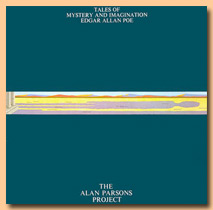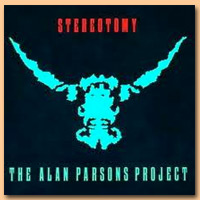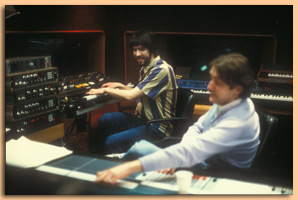The Alan Parsons Project
 Andrew reminisces about his work as arranger, conducter, and musical director for The Alan Parsons Project.
Andrew reminisces about his work as arranger, conducter, and musical director for The Alan Parsons Project.
Sometime early in 1975, Alan Parsons phoned me to ask me to a meeting with his manager, Eric Woolfson. We met for tea at the Dorchester Hotel in London. He had an idea for a new album, based on the stories of Edgar Allan Poe, and wanted me to become involved as arranger, conductor and co-writer. I had met Alan some time before when Steve Harley insisted on using me to arrange Cockney Rebel’s 2nd album The Psychomodo. Alan liked my unusual approach to arranging - he said I was the only arranger he had worked with who doubled string lines with wind instruments (a common enough trick in Classical music), and who used avant-garde textures (as in the title Ritz on The Psychomodo).
 So a long process began of working on the songs and on the lengthy suite about The Fall of the House of Usher, a process that was really enjoyable, although hard work: we all felt that we were doing something that hadn’t been done before in quite the same way. We used unusual seating layouts for the orchestra for stereo effects on some titles: most of the orchestra was recorded at Abbey Road, except for the very large orchestra used on Usher which was done at the old Kingsway Hall in central London - which had a great acoustic, but one could occasionally hear the underground trains during quiet passages! Alan and I both still feel that this is our favourite APP record.
So a long process began of working on the songs and on the lengthy suite about The Fall of the House of Usher, a process that was really enjoyable, although hard work: we all felt that we were doing something that hadn’t been done before in quite the same way. We used unusual seating layouts for the orchestra for stereo effects on some titles: most of the orchestra was recorded at Abbey Road, except for the very large orchestra used on Usher which was done at the old Kingsway Hall in central London - which had a great acoustic, but one could occasionally hear the underground trains during quiet passages! Alan and I both still feel that this is our favourite APP record.
 With I Robot we still had the feeling of breaking new ground - two tracks in particular (Alan’s Nucleus and my Total Eclipse) were not the sort of titles one usually came across on a rock album. There were some very good songs there too - my favourites are Don’t Let it Show, beautifully sung by Dave Townsend, and Breakdown, with its Handel-like choir. Pyramid had some fine moments: best among them - Colin Blunstone’s haunting vocal on The Eagle will Rise Again, and John Miles’ performance on Shadow of a Lonely Man.What Goes up is another favourite. Eve was something of a disappointment to me: one of the weaker albums overall both musically and sonically.
With I Robot we still had the feeling of breaking new ground - two tracks in particular (Alan’s Nucleus and my Total Eclipse) were not the sort of titles one usually came across on a rock album. There were some very good songs there too - my favourites are Don’t Let it Show, beautifully sung by Dave Townsend, and Breakdown, with its Handel-like choir. Pyramid had some fine moments: best among them - Colin Blunstone’s haunting vocal on The Eagle will Rise Again, and John Miles’ performance on Shadow of a Lonely Man.What Goes up is another favourite. Eve was something of a disappointment to me: one of the weaker albums overall both musically and sonically.
 The Turn of a Friendly Card was a return to form: a couple of classic songs - Time and, of course, the title track...overall a much stronger album than the previous one: the “suite” on side two linking five titles into one unit, was a move away from the format of “just a bunch of songs”. The next album, Eye in the Sky, was the highest-charting album to date and had some strong songs - Silence and I, Old And Wise & Psychobabble are the ones I enjoyed working on most: Silence and I used the largest orchestra of any APP track - over 100 performers including no less than 20 1st violins!
The Turn of a Friendly Card was a return to form: a couple of classic songs - Time and, of course, the title track...overall a much stronger album than the previous one: the “suite” on side two linking five titles into one unit, was a move away from the format of “just a bunch of songs”. The next album, Eye in the Sky, was the highest-charting album to date and had some strong songs - Silence and I, Old And Wise & Psychobabble are the ones I enjoyed working on most: Silence and I used the largest orchestra of any APP track - over 100 performers including no less than 20 1st violins!
 Ammonia Avenue always struck me as Eye in the Sky Part II - there are several parallels here - Prime Time was like a continuation of Eye in the Sky, Ammonia Avenue itself was a child of Silence and I... with a similar large orchestral feature in the middle. It was the first album on which The Philharmonia Orchestra was used rather than a contracted orchestra: my relationship with them had started on the “Scrabble” album - largely because of a remark made by my old friend John Wallace, their principal trumpet player (who had played on almost all APP tracks with trumpet parts) asking me why I didn’t use them! (They also played on the Ladyhawke soundtrack.)
Ammonia Avenue always struck me as Eye in the Sky Part II - there are several parallels here - Prime Time was like a continuation of Eye in the Sky, Ammonia Avenue itself was a child of Silence and I... with a similar large orchestral feature in the middle. It was the first album on which The Philharmonia Orchestra was used rather than a contracted orchestra: my relationship with them had started on the “Scrabble” album - largely because of a remark made by my old friend John Wallace, their principal trumpet player (who had played on almost all APP tracks with trumpet parts) asking me why I didn’t use them! (They also played on the Ladyhawke soundtrack.)
 Stereotomy (a great title! - harking back to Edgar Allan Poe again) also used The Philharmonia Orchestra. Where’s the Walrus was particular fun to write - with the violins chasing and shadowing Ian’s guitar licks. John Miles made a welcome return to vocal duties on the title track. Gaudi came about as a result of my introducing Eric to the great Catalan architect’s work on an interview tour of Spain which we undertook for the “Scrabble” album: Eric was deeply impressed with his work. Again, John Miles gave a great performance on the title track.
Stereotomy (a great title! - harking back to Edgar Allan Poe again) also used The Philharmonia Orchestra. Where’s the Walrus was particular fun to write - with the violins chasing and shadowing Ian’s guitar licks. John Miles made a welcome return to vocal duties on the title track. Gaudi came about as a result of my introducing Eric to the great Catalan architect’s work on an interview tour of Spain which we undertook for the “Scrabble” album: Eric was deeply impressed with his work. Again, John Miles gave a great performance on the title track.

The rather wordily titled “Andrew Powell and the Philharmonia Orchestra Play the Best of The Alan Parsons Project” was mainly recorded at Abbey Road, with the exception of the orchestral session for the I Robot Suite, which was done at CTS in Wembley. It was Helmut Fest at EMI Records who suggested using the Scrabble board as a way of getting around the world’s longest album title. One of the biggest difficulties I found in orchestrating these tunes is that certain kinds of “rock” themes sound like muzak if they are played by a violin or other string section: hence the solo sax on Games People Play.

I also deliberately started some of the tracks with an intro which didn’t give the following song away! The I Robot Suite was an interesting challenge - at times there are themes from two songs being played at once as counter-melodies to each other - it was fun to try to link songs whose musical styles were quite different: I wanted to do something different with one of my favourite albums.